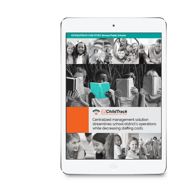
The United States is a land of immigrants. It has been from the beginning, and people from other countries continue to move here for the opportunities the US offers.
Immigrants bring with them a wealth of culture and language, both of which sometimes pose some challenges in connecting with immigrant parents and children. You can improve your relations with them by embracing their culture and who they are as they continue to learn English and settle into American life.
Learn more about connecting with non-English speaking parents in this post.
Acceptance Is Crucial
An essential part of building and maintaining a connection with parents that speak a different language is accepting the family and embracing where they are from. Create a welcoming space where they feel safe to be themselves.
Don’t embarrass them about their cultural heritage, including the way they dress or speak. Also, don’t assume their customs are the same as the community's or yours. Embrace their differences, and don't be afraid to ask them to help you understand.
Determine the Best Way to Facilitate Involvement
When English is not a parent’s first language, you must be a mindful educator and find ways to facilitate their involvement in their children's care and education. Many cultures hold educators in high esteem, and parents may only be waiting for an invitation to help.
Do ensure you can provide them with the information to which they are legally entitled. Find ways to keep them informed about enrollment, parent-teacher conferences, and services such as English as a Second Language and special education.
Listen to Learn
Ask questions and listen to what the parents have to say.
Ask about their language preferences for communicating with your facility. Please don't assume that they are not comfortable speaking English. However, if they prefer to speak in their language, find a way to translate speech between you. Never ask their child to translate for you except in emergencies.
Do research and take some time to learn about their language and cultural heritage. Learn a few words and ask about their country. What does it look like? What sports are popular? Speak about more than their child and the care facility or school.
Above all, avoid stereotyping. Never assume anything you learn through movies or books is correct. For example, if you celebrate Hispanic heritage at your facility, offer something more than tacos. Not all Hispanic peoples are from Mexico.
There are multiple official languages in some countries — be mindful of how you present languages other than English to your classes. India has 15 official languages and multiple unofficial ones. Remember that English spoken by someone who learned in another country may differ from American English.
Follow the parent’s lead and ask about anything you don’t understand. Also, invite them to make any cultural representations they like outside of classwork. Ask parents to volunteer in ways that make them comfortable.
Use Standard English
English language learners face a steep learning curve. American English has a multitude of differences from “correct” or standard English. When speaking with someone learning the language, avoid slang, idioms, and analogies unless you are sure they understand it.
On the other hand, don't treat non-English speakers like children. They are adults. Speak to them as such. Speak slowly and clearly, taking your cue from their body language and actions. Use positive tones and celebrate successes as much or more than negative issues.
Whenever possible, hire staff that reflects the cultural diversity of your facility. If they can help with language, so much the better!
Rely on Visual Cues
Everybody understands a smile. Keep your demeanor friendly and warm. When using calendars and other visuals, utilize easily understood icons and plan long-term. Parents don’t want to miss important events.
Color code school communications and homework assignments. It not only helps new English speakers to find important information quickly, but it also streamlines communication for you and your staff.
Make use of images, photos, and videos in your newsletters and on your website. The axiom that a picture is worth a thousand words still holds true.
Stay Connected
As you should with all parents, keep in touch throughout the year. Don’t let the relationship end with enrollment and onboarding.
Repeated touches help you learn more about the family and how you can help them and their children learn about support programs and other needs. Host parent-teacher conferences and keep parents updated through email or other means.
If you can’t provide a translator, try out Google Translate. Copy and paste your information into the application and use the translation in your communications. It isn’t perfect, but you can ask forgiveness for anything awkward. Most parents will understand.
EZChildTrack's Parent Portal can help you maintain parental connections, reducing administrative work and increasing satisfaction with your services.
The Parent Portal is an online interface that provides parents with quick and easy access to information. You can configure it to meet your program’s requirements and branding.
Parents and staff can find many reasons to use the portal, including:
- Making online payments
- Registering online for programs and events
- Managing schedules and enrollment in activities
- Managing child, family, and emergency information
- Enrolling in autopay and tracking all account transactions
- Printing tax statements
- Viewing bulletins and the school calendar
- Downloading forms or fill them out online
If possible, provide information in the language preference of the family or consider creating bilingual forms. You can also give examples of completed lessons, provide video lessons, and find other ways for parents to help their children.
Be a Mentor
Encourage collaborative work between children at school with a homework buddy system or hosting a homework club.
Every contact you make helps further your understanding of the non-English speaking parent’s culture and needs. It also expands their knowledge of their new home.
Connecting with non-English speaking parents is an essential part of your facility’s purpose. A rich relationship rewards both sides with a broader understanding of the world and our place in it.




